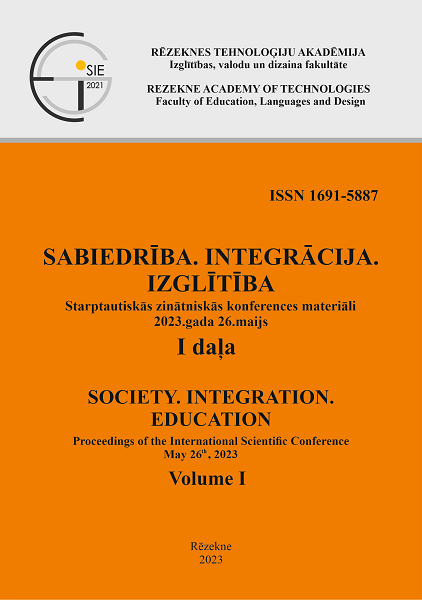LATVIAN HIGHER EDUCATION INSTITUTION STUDENT FOREIGN LANGUAGE LEARNING STRATEGIES
DOI:
https://doi.org/10.17770/sie2023vol1.7165Keywords:
health care students, HEIs (higher education institutions), sport science students, Strategy Inventory for Foreign Language Learning (SILL)Abstract
The study focused on the frequencies of Latvian higher education institution student self-reported foreign language learning strategies. From the 86 participants 44 were males and 42 – females; sport science was studied by 48 respondents, and health care by 38; 44.20% were freshmen and 55.80% - sophomores; 76.70% were full-time and 23.30% – part-time students. The study employed the Strategy Inventory for Foreign Language Learning (SILL), consisting of 50 statements divided into 6 categories: memory, cognitive, compensation, metacognitive, social and affective. One statement from the memory strategies was removed, as it was considered non-relevant for the students. Likert scale of three choices - never, sometimes and often – was used. SPSS Version 26 was used for the data analysis. Results: 1) the investigated students tended to use cognitive (mean =2.12; st.dev.=0.29; min,=1,43; max.=3) and compensation (mean =2.11; st.dev.=0.36; min.=1,33; max.=2.83) strategies more often; 2) the students tended to use affective (mean =1.78; st.dev.=0.39; min.=1.00; max.=2.67) strategies less often; Wilcoxon Signed Ranks Test showed that compensation strategies are used more often than memory strategies (Z=5.08; Sig. =0.00) and metacognitive strategies were used more often than affective strategies (Z=5.00; Sig. =0.00).
References
Bessai, N. A. (2018). Using Oxford’s Strategy Inventory of Language Learning (SILL) to Assess the Strategy Use of a Group of First and Third Year EFL Algerian University Students, American Scientific Research Journal for Engineering, Technology, and Science (ASRJETS) Volume 42, No 1, pp.166-187.
Bremner, S. (1998). Language Learning Strategies and Language Proficiency: Investigating the Relationship in Hong Kong, Reprinted from Asia Pacific Journal of Language in Education, Vol.1, Issue No.2. p. 490-513, with permission.
CEFR - Common European Framework of Reference for Languages: Learning, Teaching, Assessment. (2001). Language Policy Division Directorate of School, Out of School and Higher Education Strasbourg, Cambridge University Press: 265 p.
Cohen, A. D. (2011). Strategies in learning and using a second language (1st ed.). New York: Taylor & Francis.
Cohen, A. D. (2003). The learner’s side of foreign language learning: where do style, strategies and tasks meet, International Review of Applied Linguistics, 41, 279-291.
Council of Europe. (2018). Common European framework of reference for languages: Learning, teaching, assessment. Companion volume with new descriptors. Retrieved from: http://www.coe.int/lang-cefr
Danko, M., & Dečman, M. (2019), The Strategy Inventory for Second Language Learning: Tested, Adapted, and Validated in the Slovenian Higher Education Context, ESP Today, Journal of English for Specific Purposes At Tertiary Level, Vol. 7(2), p. 207-230, e:ISSN-2334-9050, Retrieved from: https://doi.org/10.18485/esptoday.2019.7.2.5
Kappler, M. B., Cohen, A. D. & Paige, R. M. (with Chi, J. C., Lassegard, J. P., Maegher, M. & Weaver S. J.). (2009). Language Strategy Use Inventory in Maximizing study abroad: An instructional guide to strategies for language and culture learning and use, Minneapolis, MN: University of Minnesota, Center for Advanced Research on Language Acquisition (CARLA), pp. 163–172.
O’Malley, J. M., Chamot, A. U. (1990) Learning Strategies In: Second Language Acquisition, Cambridge, UK: Cambridge University Press.
Oxford, R. L. (1990). Language learning strategies: What every teacher should know (1st ed.). Boston, Mass: Heinle ELT.
Oxford, R. L. (2003). Language learning styles and strategies. Berlin: Mouton de Gruyter.
Riazi, A. (2008). Language Learning Strategy Use: Perceptions of Female Arab English Majors. Foreign Language Annals, Vol.40, No.3. DOI: https://doi.org/10.1111/j.1944-9720.2007.tb02868.x
Rudzinska, I., & Jakovleva, M. (2019). Health Care and Sport Student English Language Learning Strategies Latvian HEI 019-05-21. Rēzekne Academy of Technologies, In: Proceedings of the International Scientific Conference; Society. Integration. Education. Volume III, Special Pedagogy, Social Pedagogy, Innovation in Language Education, DOI: https://doi.org/10.17770/sie2019vol3.4009
Vertongen, N. (2014-2015). The relationship between the use of language learning strategies and English language proficiency, Faculteit Letteren & Wijsbegeerte, Academiejaar 2014-2015, Universiteit Gent.
Wu, Y. L. (2008). Language learning strategies used by students at different proficiency levels. Asian EFL Journal, 10(4), 75-95.






